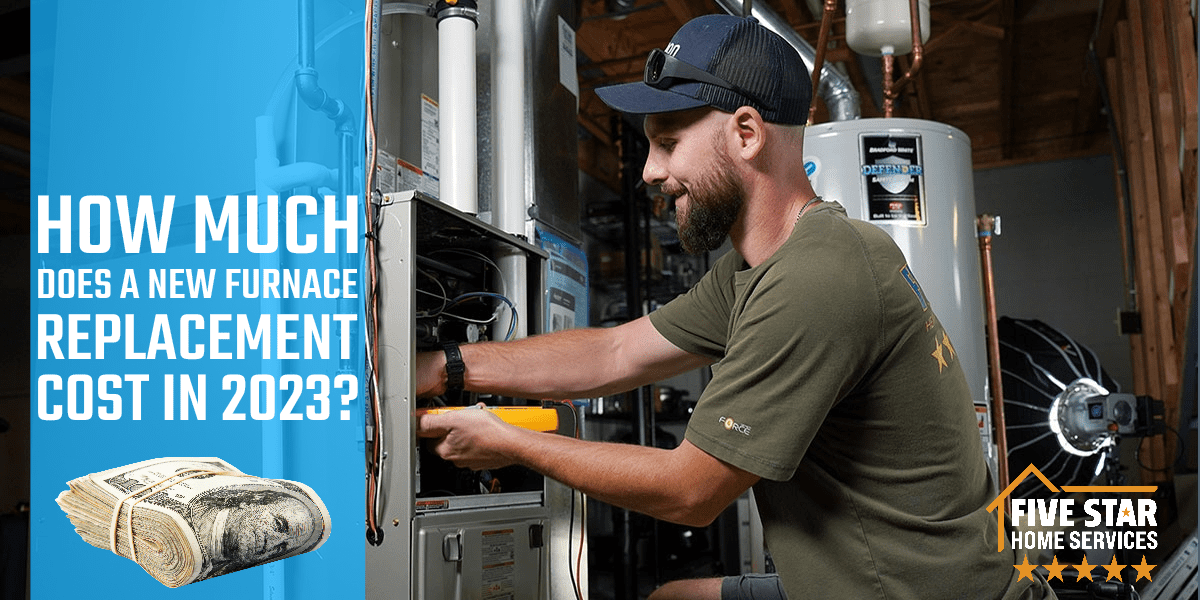As your local comfort team in Central Ohio, Greater Dayton, and Greater Cincinnati, we at Five Star Home Services break down each aspect of pricing for a furnace replacement in the following. We aim to give you ranges of pricing for new equipment and installation to better set your budget and make the best decision for your home.

What Does It Cost to Replace a Furnace in Central Ohio?
Furnace replacement can cost anywhere from several thousand all the way up to $8,500, depending on the type of equipment, the size of your home or building, and the efficiency rating of the new heating equipment. Keep in mind this cost estimate includes labor and permit fees, not merely the HVAC equipment costs.
In any case, this price range accounts for smaller homes and homes that are up to (and over) 5,000 square feet. This also includes single-stage, two-stage, and variable-speed furnaces, in addition to each of those types in both standard and high-efficiency models. Additionally, your home’s size and your comfort and air quality preferences will also affect the final pricing.
While most homeowners are unaware of the vast diversity of furnace costs, as well as the things that factor into those costs, all is not lost. If you are among those homeowners, don’t fret; your friends at Five Star Home Services are here to help!
We plan to explain all the price ranges in addition to explaining why those ranges exist, what each means for your overall comfort, and more. Remember, you’re always in good hands with Five Star Home Services! We’ve got all your comfort needs covered, and we explain everything carefully and completely!
Oh, and one other nice thing is that we give you the full cost of equipment and installation. Ranges provided will also include items like the cost of pulling inspection permits, which are often included as “hidden” fees. Additionally, some pricing guides will include equipment only, and some in-home estimates will omit certain fees in order to get you to sign a contract.
We believe this is very misleading. We have your home and your comfort interests at heart. So, we are always 100% transparent! You’ll never question our honesty and loyalty. Although it is true that some modifications and additions can change costs beyond the ranges we provide, our pricing is fairly standard for most homeowners. We can also walk you through some of the reasons you might incur those additional costs. Eventually, you will be able to have confidence in setting a budget for your new home heating system.
A list of some items we’ll cover that affect the cost of any new furnace installation includes the following:
- Capacity (size) of the furnace
- Matching equipment so all technology is compatible
- The efficiency of your new furnace and how it relates to your entire HVAC system
- Speed options related to the blower motor can increase cost but also increase your options and comfort.
Additional costs include the following:
- Ductwork and ventilation modifications
- Installation of a gas line if you’re converting to a natural gas furnace
- Indoor air quality products such as better media filters and humidity-controlling products will increase your initial cost but can potentially save you money long-term
- Capacity of Your Residential Furnace
Whenever one of our sales professionals from Five Star Home Services visits your home, they should perform a Manual J Load Calculation to determine the capacity required in an HVAC system to properly heat and cool your home. The industry standards for these calculations are set by the Air Conditioning Contractors of America (ACCA). At Five Star Home Services, we always perform an ACCA-approved load calculation to ensure accurate sizing of your system. We leave no stone unturned.
We want you to know the capacity required to service your home properly. The size of your home also matters. Additional things include factors like the number and direction of the windows in the home, as well as dozens of other factors.
Naturally, larger systems tend to cost more. It’s important to get the correct capacity for your home, though, because you’ll be losing massive amounts of efficiency if the furnace capacity is too little or too much.
Furnace Efficiency and Cost
For central air conditioners, the most common metric for measuring efficiency is SEER Rating, which, in brief, is a calculation that compares energy usage to overall cooling effectiveness.
Furnaces, on the other hand, use the metric of Annual Fuel Utilization Efficiency (AFUE). This is measured on a scale of 1% to 100%. So an AFUE of 80% indicates that 80% of the fuel in the system is being turned into usable heating. The remainder ends up being vented through the system’s exhaust.
Although fuel efficiency averages range a bit depending on the fuel type, the current minimum AFUE for new furnaces is 78%. Currently, the highest-efficiency units available on today’s market generally run between 90 and 97%. Any modern system will likely be more efficient than an older system.
Although efficiency ratings aren’t the only aspect of a home heating system’s total overall efficiency (which includes things such as the quality of installation and filtration), in general, higher-efficiency furnaces have two main benefits:
- Higher Initial Cost
- Lower Long-term Costs
Wherever you fall on that budgetary scale is a personal decision that your trusted HVAC partners here at Five Star Home Services can discuss with you right away!
Furnace Speed Options
Perhaps you have heard the term “variable speed” in reference to HVAC equipment. Perhaps not. Sometimes this term is used in regard to your air conditioner. However, even when it isn’t, it also concerns your home heating system. More specifically, it concerns your blower motor inside the furnace. Blower motors are used to move air throughout the system.
Basic furnaces have a single-stage blower. This means it is either off or on. Beyond that, there aren’t any degrees of control between these two. Two-stage motors will usually have a 100% setting, then another that’s lower (~70% power). These two provide additional control and comfort.
Variable-speed systems can have hundreds of individual settings of speed, offering precise control over your heating and cooling.
Unsurprisingly, it also costs more upfront.
Like a lot of other items in this article, the tradeoff in initial price is tied to comfort and levels of control, as well as long-term energy costs. Variable-speed systems use less energy over time, which makes them a better long-term investment. Furthermore, it’s also important that the blower motor in the furnace is compatible with your air conditioner. Next, this leads us to equipment matching.
HVAC Equipment Matching
Whether we like it or not, all technology today is moving toward being “smart.” Smart technology communicates between systems dynamically. And HVAC equipment is no exception — even if there are varying levels of communication depending on your system.
Single-stage, two-stage, and variable-speed equipment needs to be able to match, as noted above. Because the elements of the furnace are providing airflow for the air conditioning unit. Likewise, things like the sizing and fuel source makes it more or less efficient whenever you pair it with different equipment. Our NATE-certified technicians handle all these details and make sure you have the right equipment matching it. Mostly, it boils down to whether you need to understand your options and how these options relate to pricing. If you own a variable-speed central air conditioner and you aren’t prepared to replace it — you will need a compatible furnace. This limits your options and puts you squarely in a higher category of initial costs. On the flip side, if you’re looking to upgrade to a variable speed unit, and your current full system only supports a single-stage, you will end up having to sacrifice efficiency. Either that or you won’t be able to upgrade to the variable speed unless you replace the entire system.
Your friendly HVAC professionals at Five Star Home Services discuss all this with you and more. You’ll never be required to perform any heavy lifting on your own. Nevertheless, it never hurts to know what your restrictions may be.
Gas vs. Electric Furnace Costs
Another important consideration is the furnace’s fuel source, which affects both equipment matching and the overall efficiency of your HVAC equipment. Electric furnaces are usually combined with heat pumps, which make electric technology more efficient. Although electric furnaces can be paired with central air conditioners, you end up sacrificing a lot of efficiency in order to do so.
In any case, gas furnaces are usually combined with standard central air conditioners. Here in Columbus, nevertheless, gas furnaces with central air conditioners are the most common setup. Because of this, it is the best solution for a lot of homeowners. Nevertheless, if you don’t have access to a natural gas line or have an existing heat pump for central cooling, an electric furnace might make more sense.
On the flip side, a lot of people see the long-term benefit of a natural gas furnace and opt to have a gas furnace installed, even if it means installing a new gas line. Gas line installation involves contacting your energy company since an HVAC contractor can only run the line from your meter to the HVAC equipment. Additionally, it can also mean installing a new gas line where none currently exists.
Electric furnaces usually cost less upfront. Their biggest costs come every month with a higher heating bill. Additionally, given the costs of natural gas, gas furnaces tend to be more cost-effective in parts of the country where winters are severe. Heat pump electric systems also tend to be more popular in more moderate climates.
Cost of a Furnace Replacement
Next, we will explore the cost of installing a new furnace. Now that we’ve covered what goes into pricing and how each area affects the final price, we will explore the various price ranges.
Mid-Efficiency Furnace (~80%)
Single-stage: $3,495-$5,995
Two-stage: $4,095-$7,395
Two-Stage Variable-speed: $4,995-$9,395
High-efficiency Furnace (90%+)
Single-stage: $4,795-$8,395
Two-stage: $5,295-$8,795
Two-Stage Variable-speed: **$6,195-$10,295**
Modulating 98% (variable-speed): $6,695-$11,595
These rates include installation and associated fees. However, it does not include ductwork, ventilation modification, or indoor air quality product add-ons. Many of these won’t be a part of every furnace installation. Additionally, it does not include various tax credits, rebates, and other incentives offered by utility companies, the government, and HVAC equipment manufacturers. We will discuss this briefly below because they can cut down on the total cost of your new equipment significantly. We all love saving money! In any case, it is important to compare quotes when you start inviting HVAC contractors into your home. Additionally, it is also important to compare apples to apples. This means not only comparing equipment, but also installation costs, installation procedures, and more. All this can either ensure or ruin, the efficiency of your new HVAC system.
Full System vs. Half System Installation
Although we might not have a choice when it comes to replacing our furnaces, homeowners can usually save money by pairing a furnace installation with a central air conditioner. Installing both of these at the same time reduces labor costs substantially compared to installing each separately. This savings can be thousands of dollars or more, depending on the system being installed.
Additionally, this also ensures that your equipment matches properly and synchronizes with things like warranties and maintenance scheduling.
If you’re close to replacement age for both air conditioner/heat pump and furnace, this is probably your best option. Nevertheless, if only one requires replacing, half installations (AC or furnace only) are also very common.
Ductwork and Ventilation Modifications
If a full-system installation saves you money, modifications to your ductwork and ventilation can increase your overall costs. A lot of older homes have inadequate ductwork to manage the airflow from modern systems. If left alone, this can diminish efficiency and can affect the health of the system by not giving it enough breathing room.
Likewise, your chimney flue might need a liner if materials aren’t able to handle the heat or pressure from the new system. This ensures optimal performance and safety of the new system.
Although both of these are much more common in older homes, it’s always best to inquire about them to know if any adjustments are necessary as part of your HVAC installation.
Indoor Air Quality Products
Although they are not directly tied to the cost of a furnace, the size and quality of your air filter can affect pricing. Additionally, add-on Indoor Air Quality products like dehumidifiers, humidifiers, and air purification products can affect pricing. These products are great because they increase the comfort of your home and the health of you and your family. They can also help your equipment run more efficiently or reduce the need to run the system as frequently.
Indoor Air Quality products represent the initial investment. However, if you suffer from allergies, mold, odors, respiratory issues, or other ailments — they may make long-term sense and can save on energy costs long-term.
These savings include the following:
Rebates: Utility companies and manufacturers often offer incentives to purchase their equipment in the form of rebates. If your HVAC contractor is especially helpful, they might offer to process these for you and to reduce the amount of your bill by the same amount so that you don’t have to worry about processing the rebate yourself. Ask our comfort team members at Five Star Home Services for details.
Tax Credits: These are usually made available for high-efficiency equipment. The federal government offers many tax credit programs on and off for years. While there’s no guarantee they’ll be available when you purchase. However, it is always worth checking.
Local Incentives: At times, companies will run individual deals or offer discounts for things like being an armed forces veteran. These will be the most variable but are again worth looking into.
Make Your Ideal HVAC Investment
The exact price of your new home heating system is only something you’ll be able to get with an in-home estimate with one of our specialists. We have a best-price guarantee, and we stand behind all of our work with a workmanship guarantee and warranty coverage you won’t find anywhere else. We hope this has given you a sense of what to expect in terms of cost, so that you can set your budget accordingly.
If you’re ready to start researching furnace financing options or to have your in-home estimate in Columbus, Dayton, or Cincinnati, Ohio, we’d love to send a Five Star Home Services sales professional over to walk you through your options and help you choose the best new furnace for you and your home. We will help you ensure that the next one lasts at least 15 to 20 years or more!
Call us today at (833) 405-8009

